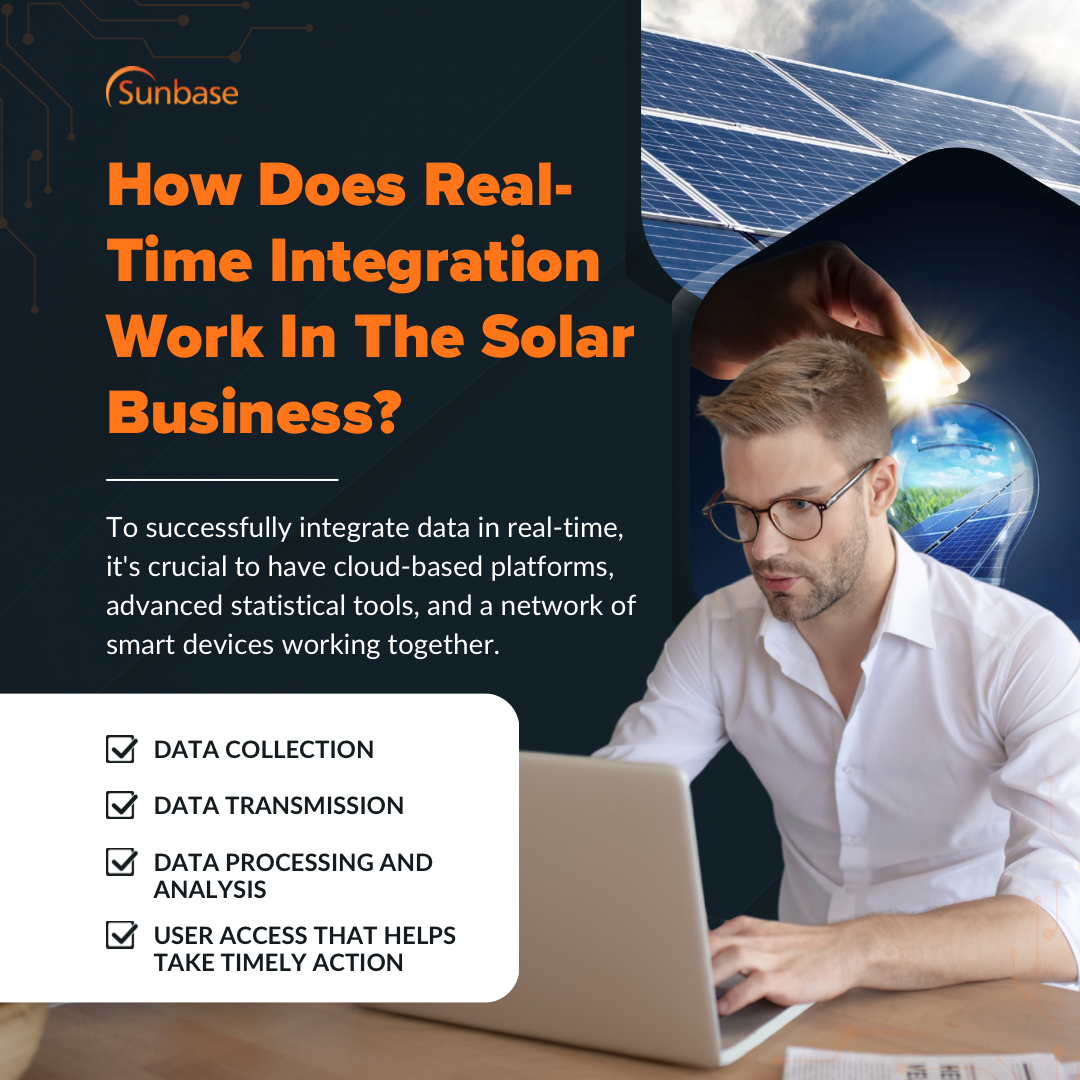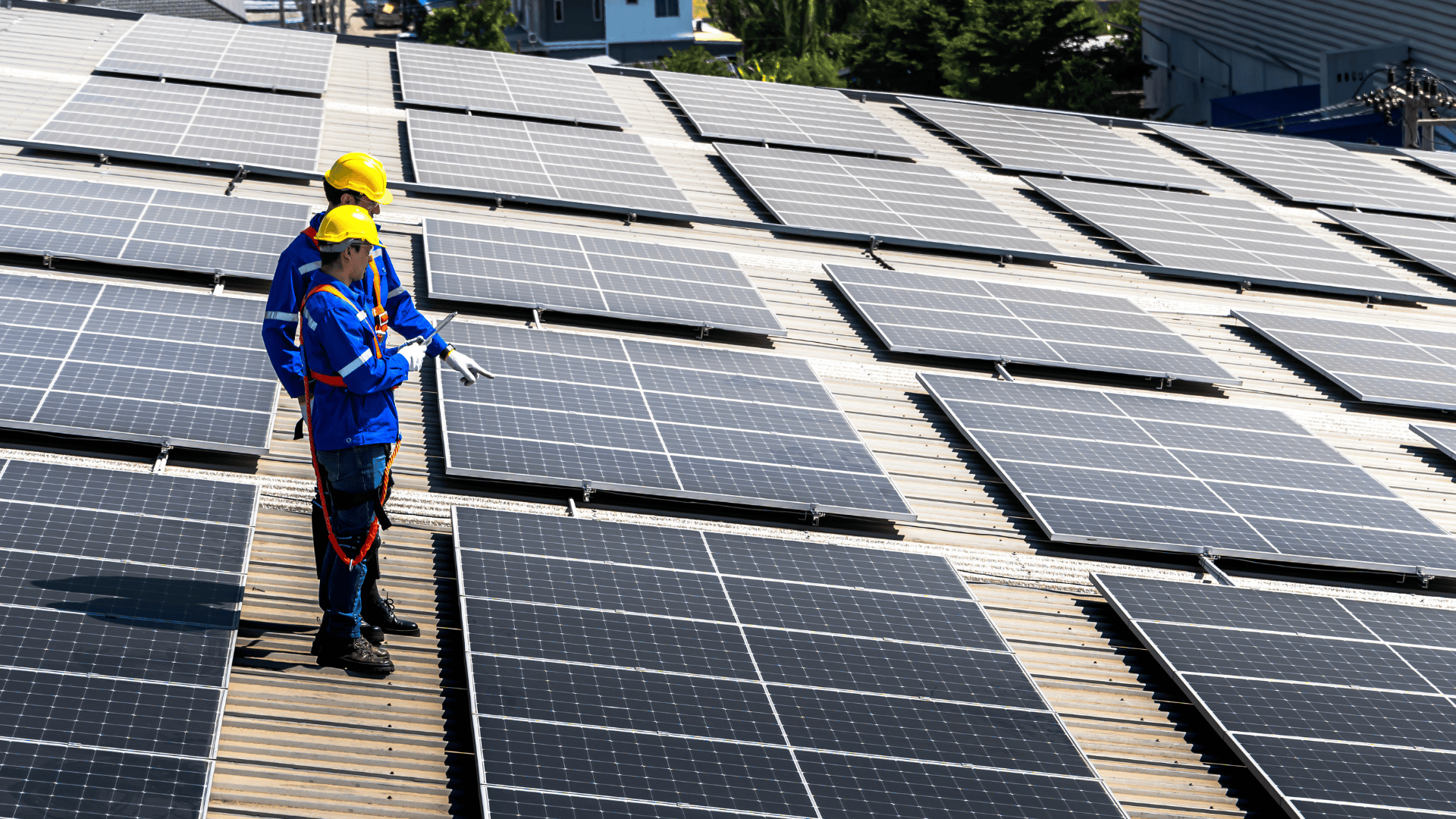How Solar Businesses Can Benefit from Real-Time Data Integration
January 30, 2025
In the solar industry, every kilowatt-hour counts. However, are you optimizing your processes, producing as much energy as possible, and providing the most incredible client experience?
Solar companies produce a lot of data, from sales and installation to operations and maintenance.
However, this data turns into a liability rather than an asset when it is kept in silos.
These silos are broken down by real-time data integration, which links every part of your company and allows you to make data-driven decisions that increase productivity, profitability, and customer satisfaction.
Bringing that data together in real-time is essential for uncovering valuable insights that can help upgrade your solar businesses. Are you prepared to use real-time data to your advantage?
Key Takeaways
- In the solar industry, real-time data integration combines sensor, weather, and inverter data, providing immediate insights for optimizing energy production and resolving issues.
- Challenges without real-time data include inefficient monitoring, management issues, reactive maintenance, and inaccurate forecasting.
- Real-time data integration enhances solar operations by improving efficiency, predictive maintenance, customer experience, energy distribution, and scalability.
The Era of Smart Solar Solutions: What is Real-Time Data Integration in Solar Businesses?
The name says it all: real-time data integration is the immediate processing of data as it is collected.
For solar companies, this involves collecting data from various sources, including weather sensors, energy meters, solar panels, and consumer usage trends, and presenting it on a single, unified platform.
Real-time data allows solar firms to:
- Track energy generation minute by minute.
- Identify and fix system inefficiencies right away.
- Provide consumers immediate access to information about their energy savings and usage.
How it works?

To successfully integrate data in real-time, it's important to have cloud-based platforms, advanced statistical tools, and a network of smart devices working together.
Let’s take a quick look at how this works:
- Data Collection: IoT devices, such as weather sensors, energy meters, and smart inverters, consistently gather data.
- Data Transmission: This data is quickly sent to a centralized platform using cloud computing or wireless connectivity.
- Data Processing and Analysis: Advanced algorithms evaluate the incoming data to identify trends, variations, and actionable insights.
- User Access: Solar business owners and clients can view this data through dashboards, applications, or automated reports to stay informed and take timely action.
Now, let's jump to the common challenges faced without real-time data.
Also, take a look at Emerging Trends in Solar Energy: A Global Perspective.
What are the Common Challenges Solar Businesses Face Without Real-Time Data?

Let's find out
1. Inefficient Performance Monitoring
Solar companies often struggle to track the performance of solar panels and inverters without access to real-time data.
Delays in detecting problems such as soiling, shading, or equipment failures can result in longer downtime, which increases operating costs and reduces energy output.
2. Project Management Nightmares
The project manager's worst nightmare is here!
They might miss key milestones, potential bottlenecks, and budget excesses without real-time data access.
3. Reactive Maintenance Instead of Proactive
Reactive maintenance strategies result from a lack of real-time insights.
This implies that issues are frequently neglected until they arise, which can lead to unexpected breakdowns and increased repair expenses.
4. Inaccurate Energy Forecasting
The most daunting task? - To accurately predict energy production without access to real-time data.
This may result in supply and demand imbalances, which could affect grid stability and cause energy waste or shortages during periods of high demand.
How Can Real-Time Data Integration Improve Solar Operations?

Here’s how:
1. Enhanced Operational Efficiency
In solar energy systems, operational efficiency is everything!
Solar companies can quickly identify inefficiencies by continuously monitoring system performance through real-time data integration. Operators can promptly resolve problems like shading or equipment failures by monitoring real-time parameters like energy production and equipment status.
Simply put, this proactive strategy maximizes energy output and minimizes downtime, improving operational efficiency and lowering expenses.
2. Predictive Maintenance
Isn’t it better to act now and fix things before encountering any problems? That's what predictive maintenance does for you!
Solar firms can use predictive maintenance techniques to foresee equipment breakdowns before they happen with real-time data.
By scheduling maintenance tasks at the best times, operators can minimize unplanned outages and repair expenses. Analyzing performance data and identifying trends can enhance equipment longevity and ensure solar systems operate efficiently.
3. Better Customer Experience
Did you know that customers really appreciate transparency and getting instant updates?
Customers want to know how their solar systems function, and real-time data enables them to track usage and savings. A notification could be sent to a homeowner, informing them that their solar panels produced sufficient energy to power their home and sell any surplus back to the grid.
Key point: Customers are more ready to invest in energy efficiency upgrades and home resilience services. (Solar Reviews)
Moral: Prioritize customer experience.
4. Improved Energy Distribution
The major climax of solar installation has arrived! Real-time data integration enables precise energy production forecasting, leading to enhanced energy distribution.
Solar companies can effectively satisfy demand by optimizing their energy output based on past performance data and current weather conditions. As the proportion of renewable energy sources in the energy mix increases, this capability becomes crucial for preserving grid stability and dependability.
Solar operators can modify their power output through grid integration in response to current grid demand, enhancing system stability and possibly increasing profits from the sale of excess energy.
5. Scalability and Growth
Growth comes with adaptability!
Real-time data integration enhances scalability for solar businesses, providing insights that inform strategic decisions. By analyzing performance metrics across large-scale solar projects
and multiple installations, companies can identify trends and growth opportunities.
Solar companies can use this data-informed strategy to optimize resource allocation, enhance operations, and ultimately drive business growth in a fiercely competitive market.
If you are wondering about its applications, here are the applications.
Applications of Real-Time Data Integration in the Solar Sector

Let's explore them:
1. Monitoring Solar Performance Metrics
Real-time data integration allows continuous monitoring of key performance indicators (KPIs), guaranteeing optimal system performance and maximizing energy yield. By examining historical and current data, you can find trends, adjust system parameters, and increase energy output.
Key metrics: Information on solar irradiance, panel temperature, solar panel health, inverter efficiency, energy generation (kWh), and other crucial factors is gathered and examined instantly.
According to a report, dust buildup on photovoltaic module surfaces can decrease their efficiency and impact the cost-effectiveness of this technology. (National Renewable Energy Laboratory) Monitoring in real-time can reduce this loss.
2. Weather Forecast Integration
While nature may be unpredictable, your solar operations can remain consistent.
The weather greatly influences solar energy output. Incorporating meteorological data with system performance data enables precise energy forecasts in the short and long term. This data can benefit grid integration, energy trading, and operational planning.
For example, if a storm is predicted, the system can automatically modify energy storage plans or schedule maintenance during periods of low solar irradiance.
3. Dynamic Energy Pricing Models
For maximizing revenue opportunities, here are some dynamic energy pricing models:
- Time-of-use (TOU) pricing: Adjusting energy consumption according to fluctuating electricity prices throughout the day to take advantage of peak solar production times.
- Demand response incentives: Engaging in demand response initiatives by modifying power output based on market signals.
- Smart grid integration: Smooth integration with the grid by dynamically adjusting power generation in response to real-time market conditions.
4. Compliance and Reporting
Quite a few laws and reporting requirements come into play in the solar business. Fortunately, the reporting procedures are streamlined, making it easier for everyone to remain compliant with the assistance of real-time data connectivity.
- Automated data reporting and logging: An extensive audit trail is generated for compliance by automatically capturing and archiving real-time data. This reduces the likelihood of errors and removes the need for manual data entry.
Real-time data integration can help adhere to industry best practices and standards, including data security, safety, and system performance.
Read our blog for Leveraging Real-Time Analytics for Solar Business Growth.
Spotlight: Sunbase’s Real-Time Data Integration

Sunbase Solar Software transforms raw data into actionable insights that increase productivity and improve your company's bottom line through smooth real-time data integration. Here's how:
Simplify procedures from Sale to O&M:
Sunbase brings together sales, design, installation, and operations & maintenance (O&M) into one seamless platform, making everything much easier for you!
Eliminating manual entry and data silos streamlines workflows and minimizes errors.
- Project information is automatically updated with data, preventing double entry.
- Real-time updates on the installation process keep everyone informed.
- Proactive maintenance is made possible by O&M teams' rapid access to system performance data.
- Its real-time dashboards provide a snapshot of your daily solar operations.
Must read: Data-Driven Insights: Leveraging Sunbase Reporting Tools for Better Decision-Making.
Are you ready for real-time change?
In a nutshell
Sun Tzu wisely stated, "Every battle is won before it's fought." Real-time data can provide the strategic insights necessary to thrive in the competitive solar market.
Integration of real-time data enables solar companies to function precisely and eliminate uncertainty.
It's time to transform unprocessed data into insight, which can then be used to make wise choices that promote productivity, profitability, and long-term growth.
Discover More About Sunbase
Data is a superpower. Are you ready to capture, analyze, and act?
Curious how Sunbase can connect all aspects of your solar business? Contact us today!
FAQ's
1. What does real-time data integration mean in the context of solar power?
Real-time data integration for solar power combines information from various sources, such as solar PV systems, weather, and energy usage. This helps solar companies monitor performance and make informed decisions. It also streamlines the process of installing solar systems.
2. How can integrating real-time data lower energy costs?
Integrating real-time data allows for identifying inefficiencies and enhances the performance of solar PV systems. Solar companies can modify their operations to improve efficiency and decrease waste by tracking energy production and usage as they occur, resulting in lower energy expenses for commercial and residential solar clients.
3. How does real-time data integration benefit solar investments?
Real-time data integration can offer valuable insights into solar PV system performance. It enables investors to assess viability and returns on investments. Access to real-time data helps investors make informed decisions, reduce risks, and maximize returns.
I agree to receive marketing messaging from Sunbase at the phone number provided above. I understand data rates will apply, and can reply STOP to OPT OUT.
Company
Industries
Features
Copyright ©2021
Terms of Service |
Privacy Policy







